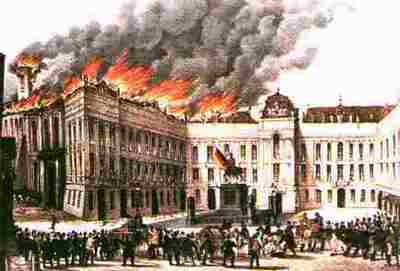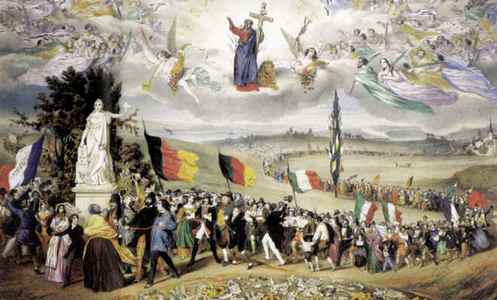- Articles Index
- Monthly Features
- General History Articles
- Ancient Near East
- Classical Europe and Mediterranean
- East Asia
- Steppes & Central Asia
- South and SE Asia
- Medieval Europe
- Medieval Iran & Islamic Middle East
- African History (-1750)
- Pre-Columbian Americas
- Early Modern Era
- 19'th Century (1789-1914)
- 20'th Century
- 21'st Century
- Total Quiz Archive
- Access Account
1848
Category: 19th Century: Political History
Causes and consequences of revolution in mid 19th Century France and Austria-Hungary
1848 was a year of revolutions, and few places in Europe managed to keep civil unrest at bay. The revolution of 1848 in France and the declaration of the Republic soon spread to other corners of Europe. The forces of change, Liberalism and Nationalism, we’re taking Europe by storm, and the old, conservative and static status quo was crumbling under the pressure of revolution. France, the home of the revolution, and the Austro-Hungarian Empire, a vulnerable target for revolution, both had their fair share of unrest and change.
Austria-Hungary and the old status quo under Metternich, like France, were also under threat from Liberalism and Nationalism. Nationalism was potentially a very destructive force within the empire, as there were so many troublesome minorities, such as the Hungarians, the Czechs and the Italians, demanding greater autonomy or even independence. Liberalism was also a potent force, with many demanding the creation of a new constitution that would guarantee civil rights and would set up an elected assembly. This was out of the question as far as Metternich was concerned. As it was in the case of France, the major factor that provided the spark for serious unrest was the economy. The countryside was getting over-populated, the harvests had failed in 1845-7, and these factors sent people looking for work in the urban areas of the empire. There was not enough work for everyone, and unemployment in towns was high. Also, in both France and Austria-Hungary, the discontented middle-class played a major role. They really acted as the mouth piece of liberalism and nationalism, which did not interest the peasantry very much at this time. Metternich’s approach to the problem also left him alienated from not only the middle-class liberals, but also the conservatives. In the end, the cause for Revolution in Austria-Hungary was a combination of economic, social and political factors, with the economic factor being the most important one. After rioting on March 13th, Metternich fled the country. Without Metternich’s strict views and policies concerning reform and the ruling elite on the defensive, concessions were made. A constitution was created and put in place, and the Hungarians gained a great degree of autonomy within Hungary with the approval of the April Laws.
Unrest was far from over in the Austro-Hungarian Empire, however. The fall of Metternich sparked uprisings and unrest in Italy and among several other national groups within the Empire. Also, the extent of civil unrest in Vienna and the fleeing of the Emperor along with his court to Innsbruck caused splits in the ranks of the revolutionaries between the moderates and the radicals. In the end, the Emperor decided to crush the revolution by force, and he had a loyal army at his disposal. The Hungarians were the last to fall, putting up a valiant struggle against the Austrians who came to subdue them with the help of some Russian forces. Monarchical absolutism was installed once more, the newly drafted constitution was ignored and things were brought back to “normal”. The greatest consequence of the Austrian revolution was probably the fall of Metternich, and what that meant for the rest of the great powers. Austria gradually distanced itself from Russia, a traditional Austrian ally since the Napoleonic Wars. The abolishment of serfdom in Austria should not be underestimated either. Serfs, slaves to the land, had been freed at least in theory. It would take some time before they could exercise that freedom in practice. The French revolution of 1848 faced a counter-revolution rather quickly. The results of the April elections had left the leftist radicals unhappy, and they attempted a coup in Paris on 15th of May 1848. With conservatives in control, rioting began on the streets of Paris once more on June 22nd. The attempted revolution was crushed. In December 1848, Louis Napoleon was elected President by a vast majority. After purging central and local governments of republicans, he declared himself Emperor of France in December 1851, and that was the end of the Second Republic. The changes between in the way the country was governed in 1848 under King Louis-Philippe and in 1851 under Emperor Louis Napoleon were not very significant; both wielded absolute power. The Second Republic, if it had lasted, would have been a great step towards democracy and liberal policies. The franchise had been expanded to include the entire adult male population. Sources:
http://fhh1.hamburg.de/fhh/internetausstellungen/hambourg-france/e/6.htmAn Introduction to Nineteenth-Century European History 1815-1914 By Alan Farmer
|



